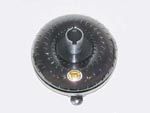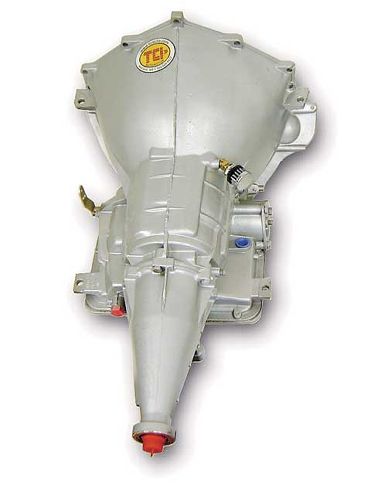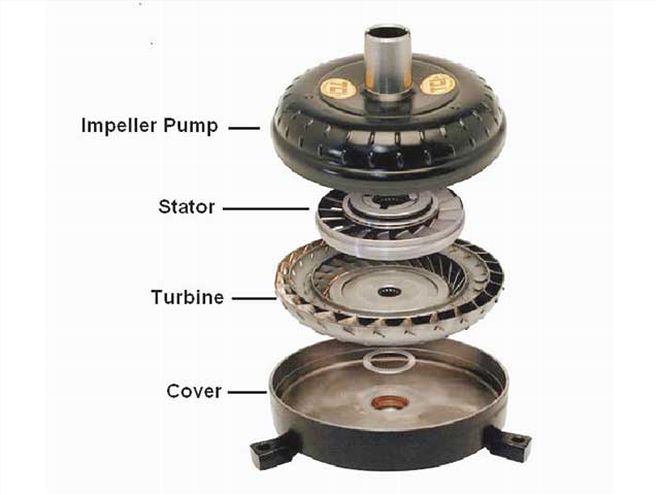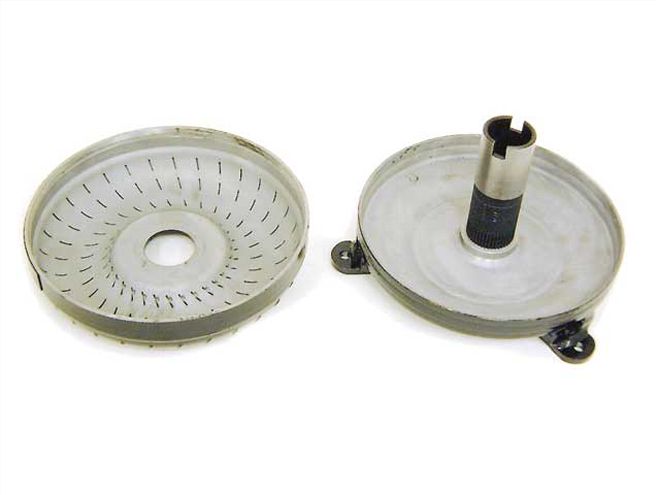
 The remanufactured and modified racing Powerglide is the most popularautomatic racing transmission in America. The TCI "clutch-less" styleunit is ideal for short-track applications.
The remanufactured and modified racing Powerglide is the most popularautomatic racing transmission in America. The TCI "clutch-less" styleunit is ideal for short-track applications.
Dummy converters, or as some people call them, hollow converters, arequickly becoming a popular item with stock class short-track teams.They allow the racer to use a direct-drive setup in a class thatnormally would be running a working converter or a "stock appearing"converter.
Standard Torque Converter
A torque converter is a fluid-coupling devicethat also acts as a torque multiplier during initial acceleration. The torque converter consists of four primary components:
 A stock torque converter has four main parts: <b>1.</b> the cover; <b>2.</b> theturbine; <b>3.</b> the stator; <b>4.</b> the impeller pump. The dummy conversioninvolves removing the stator and the turbine as well as the internalfins in the impeller pump.
A stock torque converter has four main parts: <b>1.</b> the cover; <b>2.</b> theturbine; <b>3.</b> the stator; <b>4.</b> the impeller pump. The dummy conversioninvolves removing the stator and the turbine as well as the internalfins in the impeller pump.
1. Cover: Thecover (also referred to as a front) is the outside half of the housingtoward the engine side from the weld line. The cover serves to attachthe converter to the flywheel (engine) and contain the fluid.
2. Turbine: The turbine rides within the cover and is attached to thedrivetrain via a spline fit to the input shaft of the transmission. Whenthe turbine moves, the car moves.
3. Stator: The stator can be describedas the "brain" of the torque converter, although it is by no means thesole determiner of converter function and characteristics. The stator,which changes fluid flow between the turbine and pump, is what makes atorque converter a torque converter (multiplier) and not a fluidcoupler.
4. Impeller pump: The impeller pump is the outside half of theconverter on the transmission side of the weld line. Inside the impellerpump is a series of longitudinal fins, which drive the fluid around itsoutside diameter into the turbine.
The Powerglide Transmission
The two-speed Powerglide transmission has become an increasingly rarefind in junkyards and old cars. Aluminum-bodied Powerglides wereproduced between 1962 and 1973 (a cast-iron version was also produced,but nobody wants them for racing). People pay anywhere from $50 to $250at a junkyard nowadays just to obtain a beat-up one. If you're looking,target old Chevy IIs, Chevelles, Camaros, Pontiacs, and some GM trucksfor Powerglide transmissions. The first generation of Powerglides(1962-'65) have pump gears on the rear support. The '66-'73 Powerglidesare considered better because the pump gears are located at the front ofthe transmission, the preferred location.
Race car builders oftenconsider the Powerglide first because of its light static weight, strongbuild qualities, and relatively low rotational mass. A typicalPowerglide often weighs about 100 pounds (plus or minus 10 pounds,depending on the equipment and whether it has a direct-drive pump or atorque converter).
Comparatively, a three-speed manual Muncie or Saginawtransmission can weigh 30-40 pounds more than a direct-drive Powerglidewhen the flywheel and clutch are included. The high cost of lighteningthose standard transmissions, combined with the expense of a racingclutch, make the Powerglide an economical winner in many cases. Now,with the dummy torque converter, it has gotten even better.
The Dummy Torque Converter
 The impeller pump has been modified to remove all of the internalcomponents. It is then welded to the cover for the final assembly. It iseasy to understand the value of losing all of that rotating weight.
The impeller pump has been modified to remove all of the internalcomponents. It is then welded to the cover for the final assembly. It iseasy to understand the value of losing all of that rotating weight.
Basically, a dummy torque converter consistsonly of a direct front pump drive inside a "gutted out" converter. Astock-working converter consists of the impeller, the stator, theturbine, and the front. The fins are removed from the impeller, and thestator and turbine are removed. The direct front pump drive is welded tothe front, and then the top is welded to the front.
The hub part of thedirect drive extends through the top, and they are welded together, thusgiving it the appearance of a normal converter. These units can be builtout of any converter core size, but the 10- and 11-inch converters aremore common. A stock-working converter can have on the average 8-10percent slippage, whereas a dummy converter has zero. The application ofpower is instantaneous.
Even an aftermarket "low stall speed" converterdesigned for a circle track application has some slippage, so all inall, you can't get any better lockup than the dummy converter. The dummyunit will hold fluid, and it will get hot just like normal fluid, but ithas no fluid actually circulating through it.
TCI installs a drain plugin the converter to allow the racer to fill the converter with fluid.The weight difference of a working converter and a dummy unit is a majorconsideration. A normal working 10-inch converter weighs 28-29 pounds,whereas a dummy converter weighs only 16 pounds. The 11-inch model hasabout the same difference in weight variance.
Less rotating weight andzero slippage mean quicker acceleration out of the corners and down thestraightaway. The fact that the unit is basically locked up helps toprovide better engine braking. When you get off the throttle, it helpsto set the car going into the corners so you can drive deeper into theturns.
Another advantage is that there are no moving parts inside adummy converter to wear out or break. To use the dummy converter, youneed a direct-drive style transmission. The Powerglide is the mostcommon automatic used in circle track racing because it has lessrotating weight than any other automatic transmission, and even lessthan that of a manual transmission.
With the TCI "clutch-less" stylePowerglide, all you need to do is put it in gear and go. You can upshifton the fly and restart in low gear. With a dummy torque converter, youwill have instant throttle response. That could be a huge plus when thegreen flag drops.
This article originally printed in March 2005